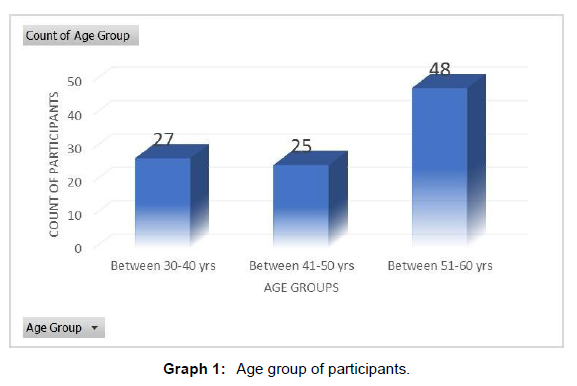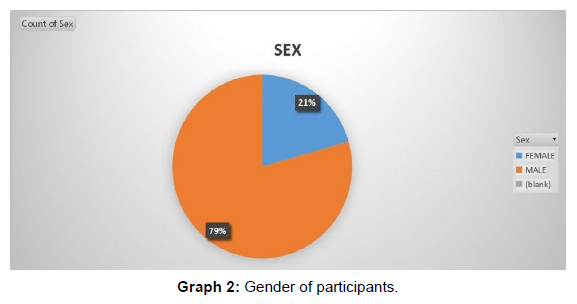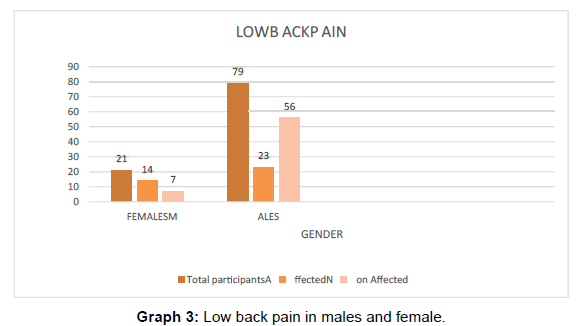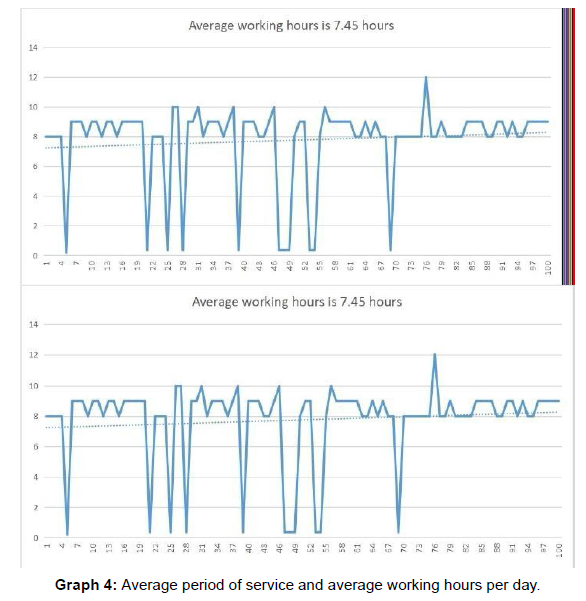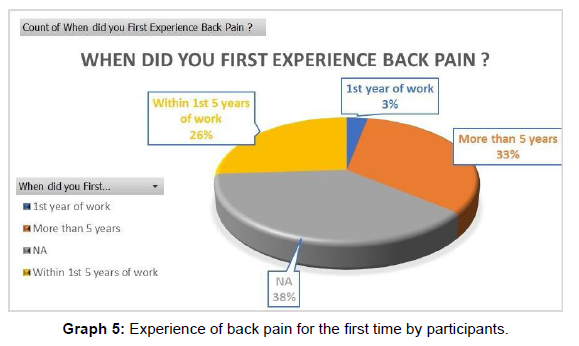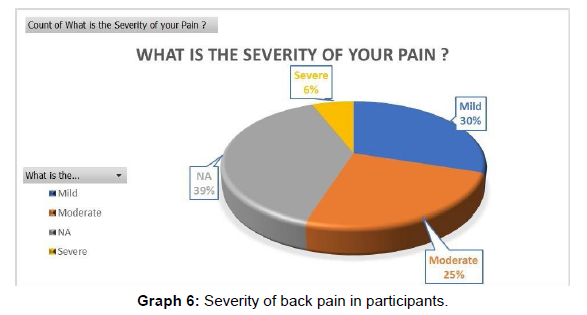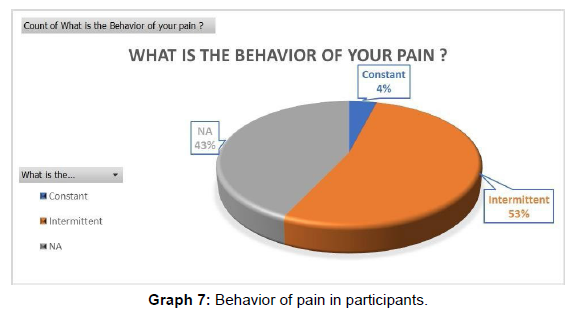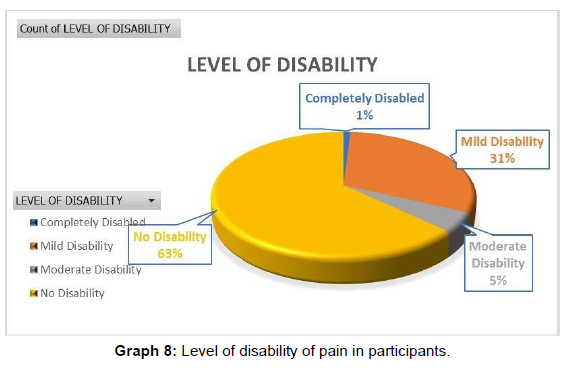Work Related Low Back Pain in Sedentary Railway Officials of the Age Group 30 to 60 Years at Chhatrapati Shivaji Maharaj Terminus Mumbai- A Survey Study
Received: 05-Jun-2023 / Manuscript No. omha-23-99899 / Editor assigned: 08-Jun-2023 / PreQC No. omha-23-99899 (PQ) / Reviewed: 22-Jun-2023 / QC No. omha-23-99899 / Revised: 28-Jun-2023 / Manuscript No. omha-23-99899 (R) / Accepted Date: 04-Jul-2023 / Published Date: 06-Jul-2023 DOI: 10.4172/2329-6879.1000467
List of Abbreviations
LBP : Low Back Pain
MLBP : Mechanical Low Back Pain.
CA : Chartered Accountant.
HOER : Hours of Employment Rules.
RA : Rheumatoid Arthritis
OA : Osteoarthritis
TB : Tuberculosis.
MOLBPDQ : Modified Oswestry Low Back Pain
PCs : Personal Computers
Introduction
Low back pain (LBP) is the most common cause of disability worldwide. [1] LBP is defined as ‘pain and discomfort’ localized below the costal margin and above the inferior gluteal folds with or without leg pain’[2] .LBP can be categorized into 3 types a) Acute, b) Sub-Acute & c) Chronic. Acute low back pain is defined as an episode of pain persisting for 7 to 10 days, sub- acute as pain persisting between 10 days to 7 weeks and chronic as pain persisting longer than 7 weeks [3]. The causes of low back pain are a) Structural (mechanical and nonspecific), b) Neoplasm (primary or metastatic), c) Referred to spine, d) Infection (osteomyelitis), e) Inflammatory (spondylitis), f) Metabolic. Mechanical back pain could be a general definition that refers to any sort of back pain caused by inserting abnormal stress and strain on muscles of the backbone. Mechanical low back pain (MLBP) is a major cause of illness and disability, especially in people of working age. Typically, mechanical pain results from dangerous habits, like poor posture, poorly designed seating, and incorrect bending and lifting motions [4] .The major contribution for low back pain comes from long sedentary hours, high amount of work load, low motivation, inappropriate sitting posture, long office hours sustaining one posture for prolonged period of time and continuing same job for many years. The five most common pain producing structure of low back are posterior longitudinal ligament, interspinous ligament , spinal nerve roots, facet joints and deep and muscles [5]. There are four types of postural alignment that deviate from the ideal alignment are as follows:
a) Kyphosis, b) Lordosis, c) Sway back and d) Flat back . Various posture attend during sitting are slouching with the shoulders hunched forward , cradling phone between shoulder and the neck , sitting with crossed legs on chair, sitting with leaning to one side of the arm rest . There are various types of sitting jobs such as a) Railway Officials, b) Bankers, c) IT Professionals, d) Teachers, e) Advocates, f) Drivers, g) Receptionist, h) CA, etc. [6] Railway officials are commonly exposed to prolonged sitting or standing, lifting heavy loads, vibration, nonneutral body posture and psychological stress due to rigid protocols and limited rest in the course of their work, particularly during locomotive engine operation, railway track maintenance, shunting and freight, fleet services which are likely to perpetuate significant ‘yellow flags’ of workers LBP [7] Men and women are equally reported to be affected by low back pain. While overall females have higher prevalence of low back pain (LBP) across all age groups, this male vs. female difference in LBP prevalence further increases after female menopause age. Postmenopausal women show accelerated disc degeneration due to relative estrogen deficiency leading to LBP. The most common age group to be affected among the males was 31-40 years of age, where 38.6% were affected, while amongst the female the most common age group to be affected was 41-50 years with 38.1%. Indian Railways is one of the biggest Government owned organization comprising of 1.6 million employees. The services of these employees are classified in to 4 major groups. Group A & B or Class I & II are officers, Group C or Class III are supervisors, ministerial staff etc., and Group D or Class IV staff are Peons, Khalasis etc. The biggest contributors for the Railway services are Group C officials.
The further detailed classification of Group C employees are as follows [8]:-
1. Technical Supervisors such as Senior Section Engineer, Section Engineer, and Junior Engineer I & II.
2. Ministerial Staff, such as Chief Office Superintendent, Office Superintendent, Gr I & II, Jr./Sr. Clerks
3. Drawing/Design Supervisors such as Senior Section Engineer, Section Engineer, Junior Engineer I & II.
4. Loco Inspectors, such as Chief Loco Inspectors, Loco Inspectors.
5. Loco Maintenance, such as Senior Section Engineer (Loco), Section Engineer (Loco).
6. Stenographers Gr. I & II.
The present survey study is to be carried out on Group C officials
1. Technical Supervisors such as Senior Section Engineer, Section Engineer, Junior Engineer I & II
2. Ministerial Staff, such as Chief Office Superintendent, Office Superintendent, Jr./Sr. Clerks) of headquarters office of Chhatrapati Shivaji Maharaj Terminus, Mumbai.
Need for study
Indian Railways is one of the biggest organization owned by the Government of India. At present, a total of about 1.6 million employees are working under this organization. Majority of the employees work in offices and come under Group C (Ministerial staff working in offices) category, which comprises about 92.6% of the entire Railway work force. Hence, nearly 1.45 million i.e 14.5 lakhs employees work in office with desk jobs. As per HOER( Hours of Employment Rules), each employee works for nearly 8.5 hours in office with half hour break for lunch. Continuous working on desktop computer results in stiffness of back and leads to low back pain. So need of the hour is to do a survey study of work related low back pain in sedentary railway officials of the age group of 30 to 60 years at Chhatrapati Shivaji Maharaj Terminus, Mumbai with help of Modified Oswestry Low Back Pain Disability Questionnaire.
Review of Literature
1. Prevalence and associated occupational factors of low back pain among the bank employees in Dhaka City. (2020); by Mohammad Ali et.al. have stated in their study that The 1-month prevalence for LBP was found to be 36.6% among the bank employees, and the prevalence was the highest (64.3%) for the 51- to 59-year-old age group. The regression analysis indicates that respondents from both age groups, 41-50 years (OR = 2.00, 95% confidence interval [CI] = 1.10-3.69) and 51-59 years age groups (OR = 5.14, 95% CI = 2.05-13.64), are significantly associated with LBP. Furthermore, obesity (OR = 2.06, 95% CI = 1.01-4.21), and prolong working hours (>9 hours) (OR = 1.42, 95% CI = 1.01-2.0) are positively associated with LBP. The top five important variables for LBP identified by random forest technique are: age, length of employment, prolongs office hours, presence of chronic illness, and physical activity.
2. Psycho-Behavioural risk of low back pain in Railway workers (2014); by K. Ganasegeran et.al. in their study stated that there were 513 study participants (70% response rate). The prevalence of LBP in the previous month was 69%. Multivariate analysis yielded four significant predictors of LBP employment of ≥10 years, lifting and lowering heavy loads, prolonged standing posture and psychological stress.
3. Prevalence and risk factors of low back pain (2018) by Jella Ramdas et. al. in their study have clarified that the most common age group to be affected among the males was 31-40 years of age, where 38.6% were affected, while amongst the female the most common age group to be affected was 41-50 years with 38.1%. Most of the patients has strenuous physical exercise on daily basis for long period of time (70.9%). 58.3% patients were under stress and anxiety, while 56.3% lifted heavy weights regularly. 44.7% persons were either overweight or obese and had LBP due to the excess weight, while 28.6% had LBP due to sitting for long periods.
4. Prevalence of back pain and associated factors among bank staff in selected banks in Kigali, Rwanda: A cross sectional study (2017) by Livingstone Kanyenyeri et.al. Have enumerated that the prevalence of back pain among the bank staff was found to be 45.8%. Multiple logistic regression revealed that having no break off during working time {AOR=3.96; 95% CI=1.71-9.20; p<0.001}, sitting in a back bent position {AOR=9.20; 95% CI=2.41-35.17; p=0.001} and sitting in back twisted position {AOR=25.87; 95% CI=6.71-99.65; p<0.001} were predictors of back pain
5. Prevalence and Risk Factors of Low Back Pain among Office Workers in Lebanon.(2015) by Wafa Bawabi et.al. Their results show that 112 (44.8%) of the recruited population suffer from back pain. Females are the most affected (68%) versus males (32%) (P=0.023). The logistic regression showed that LBP was positively associated with backbone crookedness (P=0.003), knee pain (P<0.001), wrist pain (P=0.002), contractions (P=0.014), numbness (P=0.009), previous treatment for back pain (P<0.001), doctor consultation (P=0.029), household work for 3-6 hours (P=0.001), maintaining same posture for > 5 hours (P=0.024), fear of changing job (P=0.036) and higher BMI (P=0.005). However, use of ergonomic chair, job advancement satisfaction, making radiography was negatively associated with LBP with P value=0.072, 0.022, 0.005 respectively. LBP has an important prevalence among office worker in Lebanon.
6. Prevalence of Low Back Pain in Sitting Vs Standing Postures in Working Professionals in the Age Group of 30-60.(2017) by Divya Pillai et.al have stated in their study that 76% of individuals with sitting occupation and 70% of individuals with standing occupations experience low back pain. 63.15% of individuals with sitting occupations and 60% of individuals with standing occupations feel that improper ergonomics might be one of the causes of their low back pain.
Methodology
Ethical approval
Ethical clearance will be obtained from the ethics committee
Study design
Cross Sectional Study.
Sampling design
Convenience sampling
Sample size
100 Samples will be taken from sedentary railway officials of the age group 30-60 years at Chhatrapati Shivaji Maharaj Terminus, Mumbai.
Inclusion criteria
1. Both male and female.
2. Group C
(i) Technical Supervisors such as Senior Section Engineer, Section Engineer, Junior Engineer I & II
(ii) Ministerial Staff, such as Chief Office Superintendent, Office Superintendent, Jr. /Sr. Clerks).
3. Desk Job.
4. Age – 30 to 60 years.
5. Those who were willing to participate in the study and ready to fill the consent form.
6. Officials who maintained a regular office hours for at least one year in railways.
Exclusion criteria
• History of acute trauma to low back, recent condition of fall, etc.
• Age below 30 and above 60 years.
• Known case of active infection e.g. TB Spine.
• Pregnant females.
• Breast feeding females & post-partum 6 months.
• Previous surgical history (lumbar laminectomy, discectomy for herniated disc, etc).
• Degenerative and inflammatory condition (RA, OA etc).
• Presently undergoing treatment /on medication for low back pain.
Materials
Data Collection Sheet, Consent Form, Information Sheet, Pen.
Outcome measures
Modified Oswestry Low Back Pain Disability Questionnaire
Procedure
1. The study is going to be carried out on sedentary railway officials (Group C (i) &(ii)) on platform no.13 at Chhatrapati Shivaji Maharaj Terminus, Mumbai in the age group 30-60 years
2. Ethical clearance will be obtained from the ethical committee of Lokmanya Medical College of Physiotherapy, Kharghar, Navi Mumbai.
3. Based on inclusion and exclusion criteria, a sample of (n=100) will be selected
4. The objectives of the study will be explained to the subjects through an information sheet.
5. The consent form will be filled by the subjects in presence of the examiner
6. Subjects were asked to rate the occurrence of pain or discomfort in the low back with 4 answering categories. No Compliant b) only once/a little c) Of short duration d) Frequently/Serious
7. Subjects who answered “No compliant or “Only once/a little” on low back pain were classified as having NO Low Back Pain.
8. Those who answered “Of short duration/some” or “Frequently/Serious” were classified as having complaints of Low Back Pain
9. Age will be categorized in to 3 Groups.
Group A- 30 to 40 years,
Group B- 41 to 50 years Group C-51 to 60 years
10. Modified Oswestry Low Back Pain Disability Questionnaire will be administered to those subjects who complained of Low Back Pain.
Modified Oswestry Low Back Pain Disability Questionnaire (MOLBPDQ)
| COMPONENTS (10 items ) | |
| Pain Intensity, | Standing |
| Personal Care | Sleeping |
| Lifting, | Social Life |
| Walking, | Traveling |
| Sitting, | Employment |
Total Score: 50
| No disability | 0-4 |
| Mild disability | 5-14 |
| Moderate disability | 15-24 |
| Severe disability | 25-34 |
| Completely disabled | 35-45 |
Reliability and validity
1. Gold standard scale for low back pain (To measure subject’s functional disability).
2. Most reliable and valid scale.
3. Sufficient width scale to reliably detect improvement or worsening in most subjects.
4. Cronbach’s alpha value = 0.90 [9-13]
Data Analysis and Results
A total of 100 Railway employees have participated in the above study.
Interpretation
Majority of the participants reported for this study were in the age group of 51 to 60 years (Total 48 participants) (Graph 1)
Interpretation
Majority of the participants were male (Total 79 participants) (Graph 2)
Interpretation
14 females were affected and 23 males were affected (Graph 3).
Interpretation
Average period of service is 22.22 years and average working hours is 7.45 hours per day (Graph 4).
Interpretation
3% experienced back pain in 1st year of work, 26% within 5 years of work and 33% in more than 5 years of work (Graph 5).
Interpretation
30% participants experienced mild pain, 25% experienced moderate pain and only 6% participants experienced severe pain (Graph 6).
Interpretation
53% of the participants experienced intermittent pain whereas 4% of the participants complained of constant pain (Graph 7).
Interpretation
31% of the participants experienced mild disability, 5% participants experienced moderate disability and only 1 participants was completely disabled (Graph 8).
Discussion
Subject study was undertaken to determine the prevalence of low back pain among Railways official at Chhatrapati Shivaji Maharaj Terminus of Central Railway in the age group of 30 to 60 years. A total of 100 participants had given their consent for the subject study. Out of the above total participants, 79 were males and 21 were females. 27 participants were in the age group of 30 to 40 years, 25 participants of 40 to 50 years and 48 participants were of the age group of 50 to 60 years.
8 Participants (4 Males & 4 females) out of a total of 28 complained of LBP in the age group of 30 to 40 years, 11 participants (7 males & 4 females) out of total of 25 in the age group of 40 to 50 years & 18 participants (12 males & 6 females) out of a total of 47 complained of LBP in the age group of 50-60 years. Hence, it can be concluded that prevalence of low back pain was more among male participants in the all age groups. The main reason behind having LBP is related to the length of service of this officials, some of whom have given more than 25 years of service and the other reason being working in sitting position for long period of time i.e., around 4-5 hours continuously in one position.
Level of disability was sought from each participant and as per record, mild disability was observed in most of the cases. Around 31 participant out of a total of 37 affected participant have complained of mild disability.
Average period of service is 22.22 years and average working hours is 7.45 hours per day. However, those who put in more hours of service without rest have complained of low back pain Targeted work involving those officials who have to constantly feed data of all running train services which are updated from time to time, sitting in one single posture are the most affected. The pain in sitting posture may arise mainly because prolonged sitting can subject the spine to various stresses i.e., the discs have to withstand a lot of compressive forces and there is an increase in intradiscal pressure, which may lead to gradual creep of tissues (Divya Pillai et.al.2018).Similar study conducted by P Shahul Hameed et al.2013 also relates to LBP among IT professionals in India who put in long working hours per week.
Severity of pain was observed and most of the participants have complained of mild or moderate pain (Mild-30, Moderate-25) and only 6 participants have complained of severe LBP.
The behaviour of pain was mostly intermittent in most of the cases. Around 53 participants have complained of having low back pain intermittently as compared to 4 participants having constant low back pain.
Clinical implication
After the completion of this study, further approach is to provide awareness and educate them about ergonomics, proper posture, need for taking break in between continuous work & relaxation, as this will ultimately improve job satisfaction and performance.
Future scope
Study should include other offices of different department with relation to their working postures.
Limitations
Disparity in volume of males and females. Study was limited to only Railway Officials of one Railway station of Mumbai only. Study included certain drawbacks regarding individual work load details and sitting ergonomics. The study does not cover consultation of doctor for pain.
Conclusion
• Based on the data collected by the researcher, it was concluded that 37 participants among 100 participants had complained of low back pain among which 23 were males and 14 were females.
• Majority of participants were suffering from mild to moderate range of pain.
• Participants with low back pain showing the mild level of disability.
• Therefore my study concluded that more number of years given to service increased the severity of pain which increased the disability of the railway officials.
Acknowledgement
First and foremost, this research would not have been possible without the grace and the blessings of the Lord Almighty. It is my pleasure to acknowledge the roles of several individuals who were instrumental for completion of my research. I wish to express my sincere thanks to my college Principal, Dr. Shweta Phadke for granting me the permission to carry out this research & providing me with all the necessary facilities.
I would also like to thank and express my sincere gratitude to my guide Dr. Tejal Pardeshi (PT), Assistant Professor who initially helped me in preparing my research study and later Dr. Jyoti Parle (PT), HOD & Professor who helped me in the final stages of my research. I would like to express my deepest sense of thanks & gratitude to the controlling officer and all volunteers of Central Railway who whole heartedly helped me in conducting this study. I take this opportunity to thank profusely all the faculty members of the Department of Physiotherapy of my college for their help & encouragement throughout my study period. My deepest appreciation with greatest debt of gratitude belongs to my father Shri D.M.Rathod & my mother Smt Vaijanti Rathod for their patience, unceasing support & encouragement. I would also like to thank my brother Mr. Dhaval Rathod and Mr. Saahil Rathod for their technical help in preparing my subject study report including Master Chart. I would also like to extend my heartfelt gratitude to thank my colleagues for their assistance & for successful completion of my research. I also place on record, my sense of gratitude to one & all, who directly or indirectly have lent their helping hand in this valuable research.
References
- Ferguson SA, Merry weather A, Thiese MS, Hegmann KT, Lu ML, et al. (2019) Prevalence of low back pain, seeking medical care, and lost time due to low back pain among manual material handling workers in the United States. BMC musculoskeletal disorders 20:1-8.
- Ramdas J, Jella V (2018) Prevalence and risk factors of low back pain.
- Magee DJ (2014) orthopedic physical assessment-E-Book. Elsevier Health Sciences; Mar 25.
- Fahmy E, Shaker H, Ragab W, Helmy H, Gaber M (2019) Efficacy of spinal extension exercise program versus muscle energy technique in treatment of chronic mechanical low back pain. The Egyptian Journal of Neurology, Psychiatry and Neurosurgery 55:1-6.
- Ali M, Ahsan GU, Hossain A (2020) Prevalence and associated occupational factors of low back pain among the bank employees in Dhaka City. J Occup Health 62: 121-131.
- Pillai D, Haral P (2018) Prevalence of Low Back Pain in Sitting Vs Standing Postures in Working Professionals in the Age Group of 30-60. IJHSR 8: 131-137
- Ganasegeran K, Perianayagam W, Nagaraj P, Al-Dubai SA (2014) Psycho-behavioural risks of low back pain in railway workers. Occupational Medicine 64:372-375.
- Designation of Group C Categories of Indian Railways.
- Towhid EA Prevalance of Low Back Pain among the Bank Workers at Some Selected Banks in Savar (Doctoral dissertation, Department of Physiotherapy, Bangladesh Health Professions Institute, CRP).
- Fritz JM, Irrgang JJ (2001) Physical therapy 81:776-788.
- Stratford PW, Binkley JM, Riddle DL (2000) Development and initial validation of the back pain functional scale. Spine 25:2095-2102.
- Fairbank JC, Couper J, Davies JB, O’brien JP (1980) The Oswestry low back pain disability questionnaire. Physiotherapy 66:271-273.
- Shahul Hameed P (2013) “Prevalence of Work Related Low Back P ain among The Information Technology Professionals in India – A Cross Sectional Study”. International journal of scientific & technology re-search 2: 80-85
Indexed at, Google Scholar, Crossref
Indexed at, Google Scholar, Crossref
Indexed at, Google Scholar, Crossref
Indexed at, Google Scholar, Crossref
Indexed at, Google Scholar, Crossref
Indexed at, Google Scholar, Crossref
Citation: Rathod SD (2023) Work Related Low Back Pain in Sedentary Railway Officials of the Age Group 30 to 60 Years at Chhatrapati Shivaji Maharaj Terminus Mumbai- A Survey Study. Occup Med Health 11: 467. DOI: 10.4172/2329-6879.1000467
Copyright: © 2023 Rathod SD. This is an open-access article distributed under the terms of the Creative Commons Attribution License, which permits unrestricted use, distribution, and reproduction in any medium, provided the original author and source are credited.
Share This Article
Recommended Journals
Open Access Journals
Article Tools
Article Usage
- Total views: 1381
- [From(publication date): 0-2023 - Mar 12, 2025]
- Breakdown by view type
- HTML page views: 1244
- PDF downloads: 137

